This Week in Labor History
October 23
President Theodore Roosevelt establishes a fact-finding commission that suspends a nine-months-long strike by Western Pennsylvania coal miners fighting for better pay, shorter workdays and union recognition. The strikers ended up winning more pay for fewer hours, but failed to get union recognition. It was the first time that the federal government had intervened as a neutral arbitrator in a labor dispute – 1902
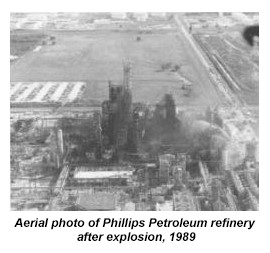 Explosion and fire at Phillips Petroleum refinery in Pasadena, Texas, kills 23 and injures 314 – 1989
Explosion and fire at Phillips Petroleum refinery in Pasadena, Texas, kills 23 and injures 314 – 1989
Postal workers Joseph Curseen and Thomas Morris die nearly a month after having inhaled anthrax at the Brentwood mail sorting center in Washington, D.C. Other postal workers had been made ill but survived. Letters containing the deadly spores had been addressed to U.S. Senate offices and media outlets – 2001
October 24
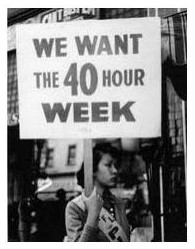
The 40-hour work week goes into effect under the Fair Labor Standards Act, signed by President Roosevelt two years earlier – 1940
U.S. minimum wage increases to 40¢ an hour – 1945
October 25
What many believe to be the first formal training on first aid in American history took place at the Windsor Hotel in Jermyn, Penn., when Dr. Matthew J. Shields instructed 25 coal miners on ways to help their fellow miners. Upon completion of the course each of the miners was prepared and able to render first aid. The training led to marked decreases in serious mining injuries and fatalities – 1899
Some 25,000 silk dye workers strike in Paterson, N.J. – 1934
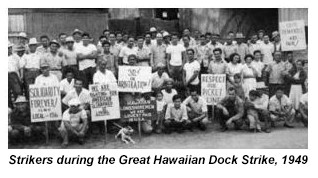 In what becomes known as the Great Hawaiian Dock Strike, a 6-month struggle to win wage parity with mainland dock workers, ends in victory – 1949
In what becomes known as the Great Hawaiian Dock Strike, a 6-month struggle to win wage parity with mainland dock workers, ends in victory – 1949
The Tribune Co. begins a brutal 5-month-long lockout at the New York Daily News, part of an effort to bust the newspaper’s unions – 1990
John Sweeney, president of the Service Employees Int’l Union, elected president of AFL-CIO – 1995
After a two-year fight, workers at the Bonus Car Wash in Santa Monica, Calif., win a union contract calling for pay increases, better breaks and other gains. “They didn’t treat us like people,” nine-year employee Oliverio Gomez told the Los Angeles Times – 2011
October 26

After eight years and at least 1,000 worker deaths—mostly Irish immigrants—the 350-mile Erie Canal opens, linking the Great Lakes and the Atlantic Ocean. Father John Raho wrote to his bishop that “so many die that there is hardly any time to give Extreme Unction (last rites) to everybody. We run night and day to assist the sick.” – 1825
October 27
The New York City subway, the first rapid-transit system in America, opens. More than 100 workers died during the construction of the first 13 miles of tunnels and track – 1904
 (Survival of the Fittest: Thanks to unions, construction jobs don’t cost lives the way they used to. If you’d like to know more about construction unions, especially if you’re considering a career in the trades, read this book. In clear, easy-to-read language it explains how to be successful in the trades and, directly linked to that success, how to make union construction thrive and prosper.)
(Survival of the Fittest: Thanks to unions, construction jobs don’t cost lives the way they used to. If you’d like to know more about construction unions, especially if you’re considering a career in the trades, read this book. In clear, easy-to-read language it explains how to be successful in the trades and, directly linked to that success, how to make union construction thrive and prosper.)
Three strikes on works-relief projects in Maryland were underway today, with charges that Depression-era Works Projects Administration jobs were paying only about 28 cents an hour—far less than was possible on direct relief. Civic officials in Cumberland, where authorities had established a 50-cent-per-hour minimum wage, supported the strikers – 1935
The National Labor Council is formed in Cincinnati to unite Black workers in the struggle for full economic, political and social equality. The group was to function for five years before disbanding, having forced many AFL and CIO unions to adopt non-discrimination policies – 1951
October 28
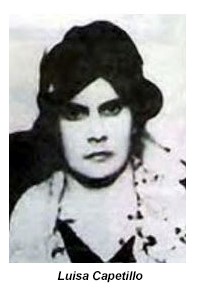 Union organizer and anarchist Luisa Capetillo is born in Ariecibo, Puerto Rico. She organized tobacco and other agricultural workers in Puerto Rico and later in New York and Florida. In 1916 she led a successful sugar cane strike of more than 40,000 workers on the island. She demanded that her union endorse voting rights for women. In 1919, three years before her death, she was arrested for wearing pants in public, the first woman in Puerto Rico to do so. The charges were dropped – 1879
Union organizer and anarchist Luisa Capetillo is born in Ariecibo, Puerto Rico. She organized tobacco and other agricultural workers in Puerto Rico and later in New York and Florida. In 1916 she led a successful sugar cane strike of more than 40,000 workers on the island. She demanded that her union endorse voting rights for women. In 1919, three years before her death, she was arrested for wearing pants in public, the first woman in Puerto Rico to do so. The charges were dropped – 1879
The St. Louis Gateway Arch is completed after two and one-half years. Originally sold as a jobs program for thousands of African Americans in St. Louis suffering from the Depression, the 630-foot high arch of stainless steel marks the Jefferson National Expansion Memorial on the waterfront of St. Louis, Mo. Although it was predicted 13 lives would be lost in construction, not a single worker died – 1965
October 29
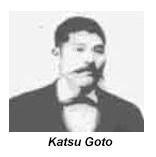 Japanese immigrant and labor advocate Katsu Goto is strangled to death, his body then strung from an electric pole, on the Big Island of Hawaii by thugs hired by plantation owners. They were outraged over Goto’s work on behalf of agricultural workers and because he opened a general store that competed with the owners’ own company store – 1889
Japanese immigrant and labor advocate Katsu Goto is strangled to death, his body then strung from an electric pole, on the Big Island of Hawaii by thugs hired by plantation owners. They were outraged over Goto’s work on behalf of agricultural workers and because he opened a general store that competed with the owners’ own company store – 1889
Wall Street crashes—”Black Tuesday”—throwing the world’s economy into a years-long crisis including an unemployment rate in the U.S. that by 1933 hit nearly 25 percent – 1929
—Compiled and edited by David Prosten
